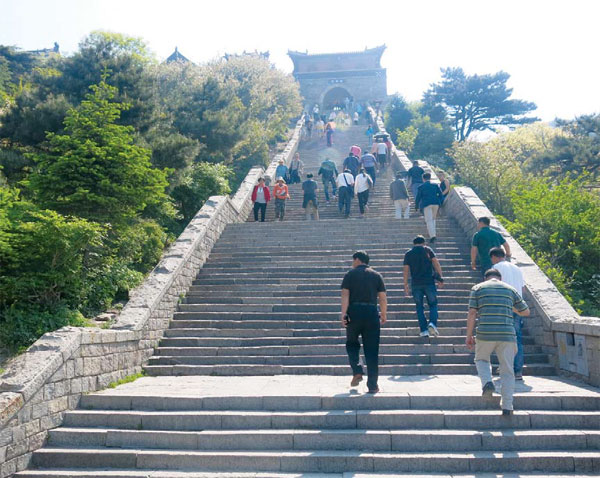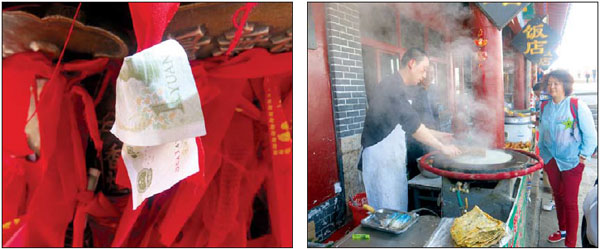Ascending 7,000 steps to the top of mount Taishan is a journey for body and soul
Close your eyes and imagine Cape Town without Table Mountain or Tanzania without Mount Kilimanjaro. Unfathomable.
The same can be said about the majestic Mount Taishan in Tai'an, Shandong province, which is halfway between Beijing and Shanghai.
|

There are about 7,000 steps to the top of Mount Taishan. Photos Yunus Kemp / For China Daily |
|

Left: A 1-yuan note is tied at a temple on Mount Taishan as a good luck charm. Right: A visitor waits for her breakfast pancake on the mountain. |
It also happens to be a sister province of the Western Cape in South Africa and ties between the two regions have grown steadily over the years. The Western Cape sent five young sailors to compete in the 7th Qingdao International Sailing Week, which ends Aug 17.
The two places are known for their outstanding beauty, exemplified by their famous mountains.
Taishan is one of five holy mountains in China and is regarded as the most worshipped. For more than 3,000 years Chinese emperors used them to pay homage to the heavens. Ascending about 7,000 steps to the top can be a religious experience.
For comfort and expediency there is a cable car, which reduces the climb to only several hundred steps. The ride in the cable car proves spectacular for viewing some of the 989 species of trees and plants.
The mountain is also home to more than 200 animal species and 122 bird species, though we didn't encounter any.
There are 11 gates, 14 archways, 14 kiosks and four pavilions, scattered along the route between the base and the summit.
En route to the cable car station, along the winding road, the town's men and women carry buckets to collect fresh mountain water. It is a local belief that drinking the water daily guarantees longevity.

If the water doesn't do the trick, the trek up and down the mountain will go a long way in accomplishing that.
A World Natural Heritage and World Cultural Heritage site of the United Nations Educational, Scientific and Cultural Organization, the mountain at its peak sits about 1,500 meters above sea level.
UNESCO describes the mountain's importance thus: "Mount Taishan is directly and tangibly associated with events whose importance in universal history cannot be minimized. These include the emergence of Confucianism, the unification of China, and the appearance of writing and literature in China."
Because it is a major tourist destination in China, all manner of food, including great savory breakfast pancakes, and drink stalls await the weary climber. We visited on a Monday morning, so there were not many tourists around.
There are also a few hotels at the top of the mountain, usually booked by people wanting to see the sunrise from the Sun Viewing Peak, although our tour guide cautioned that the accommodation was of a poor standard and the amenities were rather spartan.
He suggested it would be a better bet to stay in a hotel in Tai'an and start climbing at least three to four hours ahead of daybreak.
Aside from the breathtaking wraparound views, the mountain is also home to the Palace of Heavenly Blessings that is inside the Temple of the God of Taishan. Other impressive man-made structures to grace this natural behemoth include the Azure Cloud Temple, with its courtyards and buildings; the Divine Rock Temple with its Thousand Buddhas hall; and an inscription which reads Most Revered of the Five Sacred Mountains on one of the many rock tablets, which is featured on the reverse side of the 5-yuan (79 US cents) bill.
At the temples, locals light incense sticks and offer prayers.
Some tie money to good luck charms, while couples write their names on locks and attach these to an installation in the courtyard of the Goddess Bixia, symbolizing their union and wishing for continued happiness. The locks from one of the many vendors will set you back about 100 yuan so pack your own if you need to.
Though the cable car saved us time and energy, the journey would have arguably been more impressive if we had climbed up.
Every famous mountain in China has cultural relics, which some locals firmly believe can be better comprehended by experiencing the climb to the top.
So why are Taoism and Buddhism elements easily found in Chinese mountains?
For the Chinese, climbing mountains is more than just sightseeing. It is a process of clearing your thoughts and a journey of mental purification.
As one local put it to me: "As I count the steps with my feet, it gives me a clear impression of how majestic nature is and how tiny humans are. The Buddhist or Taoist temples on top take my breath away.
"It is strong willpower that leads me to this height. I believe that is why the emperors came this far to worship the gods by showing their sincerity. Scholars left their masterpieces of inscriptions with the inspiration of the beauty of nature.
"That is why I recommend you climb up the mountain without the help of modern facilities. After spending three or four hours walking, feeling and experiencing on the way up, the money you tie and the lock you attach mean much more than just being souvenirs."
Like the Western Cape, Shandong province, with a population of 98 million, is also known for its beautiful coastline that stretches for more than 3,000 kilometers.
Jinan, known in China as the City of Springs, is its capital.
The pretty city of Qingdao, known as the World Beer City, is a popular tourist destination. Here is the world-famous Tsingtao Brewery, established in 1903 by German settlers.
It is China's second-largest brewery and the old German brewery still stands next to its more modern counterpart. Guided tours are available for both breweries as well as for the former German governor's manor.
The Germans colonized Qingdao in the early 1900s and the Japanese occupied the area in 1914 before the Chinese regained control in the 1920s.
Qingdao is also popular with couples, who favor the seaside city to take pictures for their wedding albums.
Shandong province is also the birthplace of influential and renowned Chinese figures: Confucius, Sun Tzu and Mencius. The whole province is rich with culture and history. Confucius' hometown of Qufu has a temple, a mansion and a cemetery paying homage to the great Chinese philosopher and it is well worth the visit.
While Jinan has an international airport, most visitors to China will start their journey from Beijing or Shanghai. From these cities, the high-speed railway is the most cost-effective and convenient way to get there: 90 minutes from Beijing and three and a half hours from Shanghai.
For more, travelchinaguide.com
The author is the deputy editor of the Cape Argus in Cape Town, South Africa. He is on a 10-month scholarship with the China Africa Press Center and is a visiting
journalist with China Daily.
(China Daily Africa Weekly 08/14/2015 page28)
|